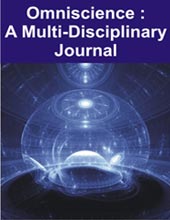Open Access

Prof. Ram Krishna Mandal,

Dr. Debkumar Mukhopadhyay,
- Professor Department of Economics, Cooch Behar Panchanan Barma University, West Bengal India
- Former Vice Chancellor, Cooch Behar Panchanan Barma University, West Bengal India
Abstract
Urbanization is a progressive concentration of people in urban areas. Quantifying urbanisation is a very challenging task. There are numerous demographic dimensions that can be used to quantify the urbanisation process, among which the degree of Urbanization and Rate of Urbanization are applied. Goal: Using Indian Census data from 1901 to 2011, this paper attempts to quantify the extent and pace of urbanisation in India. Methods: The study is descriptive in nature and is based on secondary sources, including books, articles, websites, online journals, and a variety of census reports. Data taken from various census repots are arranged in such a way so that the necessary tools like the formulae of degree of urbanization and rate of urbanisation can be applied. Results and Discussions: India’s urbanization has been rapidly increasing over the past 20 years. It is clear that India is not one of the world’s most urbanised nations. About 20 years ago, the actual process of urbanization began in India, and since then, it has gained enough momentum to absorb a sizable portion of the rural population. Rate of urbanization and degree of urbanization in India are measured on the basis of data of urban population from 1901 CE to 2011 CE. Findings: The Degree of Urbanization and Rate of Urbanization, both indicate a moderate rate of urbanization. In conclusion, stabilising the population is essential to promoting sustainable development. The pressure on urbanisation is growing as the global population grows in a geometric manner. Conclusion: Encouraging sustainable development necessitates population stabilization. As the India’s population rises geometrically, there is increasing strain on urbanization, arable land, water, energy, and biological resources to produce adequate food while maintaining the integrity of our ecosystem. India’s population policy must be founded on practical steps that not only address our population issue but also enable the impoverished to make real and significant life improvements.
Keywords: Progressive Concentration, Demographic Dimensions, Population, Sustainable Development, Population, Sustainable Development.
[This article belongs to Omni Science: A Multi-disciplinary Journal(osmj)]
Browse Figures
References
- Breese, G. Urbanisation in Newly Developing Countries. Prentice Hall. New Delhi; 1969.Available from https://egyankosh.ac.in/bitstream/123456789/9891/1/Unit-11.pdf
- Davis K. India’s Urban Future: Selected Studies from an International Conference Sponsored by Kingsley Davis, Richard L. Park [and] Catherine Bauer Wurster. Edited by Roy Turner. Univ of California Press; 1962.
- Davis K. The urbanization of the human population. InThe city reader 2015 Jul 16 (pp. 43–53). Routledge.
- Peng X, Chen X, Cheng Y. Urbanization and its consequences. Paris, France: Eolss Publishers; 2011.
- Urbanisation Trends in India [Internet]. Google Books. 2024 [cited 2024 Jan 10]. Available from: https://books.google.co.in/books/about/Urbanisation_Trends_in_India.html?id=LY8iAAAAMAAJ&redir_esc=y
- Theories of City Size Distribution and Indian Urban Structure-A Reappraisal. Economic and Political Weekly [Internet]. 1983 Jul 30 [cited 2024 Jan 10];18(31). Available from: https://www.
epw.in/journal/1983/31/special-articles-special-articles/theories-city-size-distribution-and-indian-urban - Kundu A. Pattern of Urbanisation with Special Reference to Small and Medium Towns in India in Chadha, G. K. Sectoral Issues in the Indian Economy. 1994.
- Kundu A, Basu S. Informal manufacturing sector in urban areas–an analysis of recent trends. Manpower Journal. 1998 Apr;34(1):21–34.
- Mitra A. Internal Migration & Economic Development In The Hills. Omsons Publications; 1997.
- Datta P. Urbanisation in India [Internet]. 2006. Available from: https://casi.sas.upenn.edu/sites/
default/files/iit/Urbanisation%20in%20India.pdf - Thakur SK. Recent Studies in Regional Urban Systems in India: Trends, Patterns and Implications. Spatial Diversity and Dynamics in Resources and Urban Development: Volume II: Urban Development. 2016:39–65.

Omni Science: A Multi-disciplinary Journal
| Volume | 14 |
| Issue | 01 |
| Received | December 14, 2023 |
| Accepted | December 28, 2023 |
| Published | January 20, 2024 |

